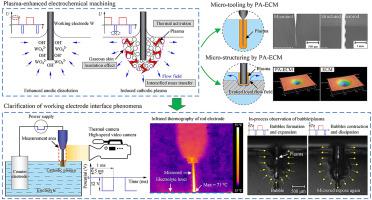International Journal of Machine Tools and Manufacture ( IF 14.0 ) Pub Date : 2020-07-18 , DOI: 10.1016/j.ijmachtools.2020.103596 Shunda Zhan , Yonghua Zhao

|
A novel hybrid electrochemical machining (ECM) approach combining a pulsed cathodic plasma and an electrochemical machining process, namely, plasma-assisted electrochemical machining (PA-ECM), is proposed in this study to strengthen the capacity of ECM, which entails both high efficiency and precision. The plasma characteristics, material removal behavior, surface topography and machining precision of PA-ECM for microtool fabrication are experimentally investigated under various conditions. The results show that PA-ECM can be realized under optimized electrical potentials with a vapor gaseous skin and electrolytic plasma layer formed around the cathode tool, of which the kinetic and thermal energies can enhance both the kinetics of the electrochemical reaction and mass transport during the ECM process. Through the design of the pulse voltage waveform, the formation and transportation of gaseous bubbles and plasmas can be well controlled. It has been shown that PA-ECM is effective and efficient for improving both the material removal rate and form accuracy in machining microtools. In the presence of plasma, a microrod tool with a high aspect ratio of 55:1 is successfully machined by PA-ECM in 5 s from its original diameter of 200 μm to approximately 18 μm, which seems to be the highest machining rate achieved so far. Additionally, in comparison to traditional ECM under the same conditions, PA-ECM provides a noticeable improvement in the microrod tool straightness error from 66.8 μm to 14.6 μm owing to the side surface insulation effect of the gaseous skin. The resulting surface roughness Ra is drastically reduced from 1096 nm to 46 nm, demonstrating that PA-ECM provides an innovative way to considerably improve the ECM efficiency without compromising the surface finish. Furthermore, the PA-ECM of microholes and microstructures are exhibited with improved precision, demonstrating the capacity of PA-ECM for micromachining.
中文翻译:

微型工具和微结构的等离子体辅助电化学加工
这项研究提出了一种新颖的混合电化学加工(ECM)方法,该方法将脉冲阴极等离子体和电化学加工过程相结合,即等离子体辅助电化学加工(PA-ECM),以增强ECM的能力,这同时需要高效率和精度。在各种条件下,通过实验研究了用于微型工具制造的PA-ECM的等离子体特性,材料去除行为,表面形貌和加工精度。结果表明,PA-ECM可以在最优化的电势下通过在阴极工具周围形成蒸气气态皮层和电解等离子体层来实现,其中动能和热能可以同时增强电化学反应的动力学和物质的传输。 ECM流程。通过脉冲电压波形的设计,可以很好地控制气泡和等离子体的形成和传输。已经表明,PA-ECM对于提高加工微型工具的材料去除率和形状精度既有效又有效。在存在等离子体的情况下,PA-ECM在5 s内成功地将高宽比为55:1的微棒工具从原来的200μm直径加工到大约18μm,这似乎是实现的最高加工速率,远。此外,与相同条件下的传统ECM相比,PA-ECM由于气态皮肤的侧面绝缘作用,使微棒工具的直线度误差从66.8μm显着提高到14.6μm。最终的表面粗糙度Ra从1096 nm大幅降低至46 nm,证明PA-ECM提供了一种创新的方法,可以在不影响表面光洁度的前提下大大提高ECM效率。此外,微孔和微结构的PA-ECM表现出更高的精度,证明了PA-ECM用于微加工的能力。











































 京公网安备 11010802027423号
京公网安备 11010802027423号